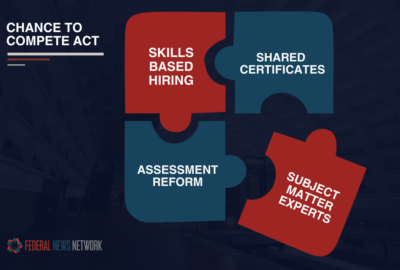Workforce cohort outlines specific ‘blueprint’ for civil service reform
For civil service reform, agencies should use lessons learned from workforce pilots at other agencies, according to a recent report from Convergence.
Many times over, federal workforce leaders have put forward possible solutions for civil service reform, often in broad strokes.
Now, a non-partisan working group is recommending what they hope are some tangible ideas to start addressing the decades-old problem of human capital management.
A recent report from Convergence, a non-partisan, non-profit organization, offers a “blueprint for action” with narrower ways agencies can try to start addressing workforce challenges.
Leading up to the civil service reform report, Convergence conducted interviews with federal leaders, union representatives and other stakeholders to assess the current challenges in the federal workforce and how to best address them.
“There are a lot of very concrete examples of things happening in one agency that could be tested or piloted at another agency. And then there are some pieces of the blueprint that are about bigger, longer-term reforms,” Convergence CEO and President Mariah Levison said in an interview. “Either way, the participants wanted to make sure there’s concrete stuff that can really get done sooner than later.”
The report’s recommendations cover four areas: Gen Z recruitment and retention; retiree hiring; cyber training and reskilling; and veterans’ recruitment and retention.
Lee Becker, a former chief of staff for the Department of Veterans Affairs’ Veteran Experience Office, now vice president and executive advisor for public sector and health care at Medallia, was one contributor to the working group discussions that eventually led to the report.
“Rather than having some very loud, bold statements, we looked at what’s really going to move the needle,” Becker said in an interview. “There’s some goodness that’s happening in government right now. How do we lift that up?”
The report, covering context, solutions and current best practices, aim to be straightforward and, ideally, not too difficult or expensive to implement.
“There’s some really solid input there from the different voices,” Caroline Chang, the report’s project director and a former Convergence official, said in an interview. “That, to me, solidifies that this should be doable. This is possible.”
Recruiting early-career employees
One of the report’s solutions for agencies, perhaps not surprisingly, is further elevating early-career recruitment and retention.
Currently, about 8.6% of the federal workforce is under age 30, according to the latest data from the Office of Personnel Management and the Office of Management and Budget. Gen Z employees — those under 25 years old — comprise just 2% of the federal workforce.
At the same time, more than 28% of the federal workforce is over age 55 — with the average age of a federal employee being 47 years old.
The Convergence report said OPM has made recent progress for civil service reform in this area, for instance by proposing regulations to update the Pathways Program, and creating a USAJobs portal targeting early-career talent.
“However, the gap demands greater and more intentional attention by all leadership,” the report said.
The report recommended agencies put their job postings on platforms beyond USAJobs, and use current early-career federal employees as “ambassadors” to encourage others to join. Additionally, the report said, improving early-career recruitment and retention will involve a larger cultural shift from agency leaders.
Many of the civil service reform report’s recommendations stem from already-existing strategies that have proven successful at a handful of agencies. The FBI recruitment portal, for instance, “highlights ‘impact’ and ‘intern voices,’” the report said.
Across agencies, OPM should consider creating early-career “cohorts” to offer opportunities for career development and peer support opportunities.
“Such cohorts would naturally drive information sharing and innovation across agencies and could eventually be allies for executing new innovations to strengthen the workforce,” the report said.
Rehiring retirees for key skills
Another often underused strategy that can help civil service reform is rehiring federal retirees, the Convergence report said.
“Talent gaps across agencies arise at all levels of experience, and sometimes occur with positions that require a level of technical expertise that may be difficult to measure through typical self-assessment questionnaires and may be difficult to fill with entry-level hires or mid-career transfers from other sectors,” the report said.
But there are certain deterrents for retirees who may be interested in rejoining federal service. One challenge deals with reductions in compensation. But in certain cases, dual compensation waivers can override those reductions. The working group recommended agencies collaborate with OPM to create pilots for adding more opportunities for using the waivers.
Similar examples from state governments can also serve as a model for how federal agencies can replicate, or adjust the concept, the report said.
For instance, the Tennessee state government offers return-to-work programs, letting retirees receive their retirement benefits while also earning wages. Tennessee’s programs let retirees work up to four months per year at up to 60% of their pre-retirement salary. As of 2022, roughly 2.5% of state government retirees were participating, the report said.
On the surface, these rehiring efforts may also appear to conflict with early-career recruitment and retention goals, the report said. But eventually, the recruitment strategy can be beneficial to both age groups.
“That’s one reason why we’re advocating for bringing back some retirees in a selective format — to be able to have them as mentors and coaches,” Becker said. “Part of it is also that we’re worried we may not have enough Gen Z employees yet to fill in the ranks. So we’re saying, let’s bring some retirees back to help — and then eventually, Gen Z will be able to catch up.”
Developing the cyber workforce
Another key area for civil service reform in the Convergence report focused on training and reskilling in cyber. Without enough attention on these skills, agencies are more likely to face cyber recruitment and retention challenges.
The federal IT workforce also has an even larger age gap than the federal workforce overall. Just 4.6% of federal IT staff are under age 30, while 17.7% are over 60 years old, according to OMB.
Focusing on cyber skills and talent has been a focus for many agencies in the past several years. But agencies should also build on recent success of federal systems meant to specifically attract cyber talent, the report said. For one, the Department of Homeland Security’s cyber talent management system can serve as a blueprint, as well as a place to incorporate lessons learned.
Reaching the goal of improving cyber skills in government can also come from internal resources, the civil service reform report said. By training and reskilling current federal employees, agencies may become better equipped as the needs for a cyber workforce grow and evolve.
Specifically, the report proposed revisiting a pilot called the “federal cybersecurity reskilling academy,” organized by the CIO Council. The initial pilot offered courses to federal employees to retrain non-IT workers with cybersecurity skills.
Of course, if taken up again, agencies should also incorporate modifications based on lessons learned from the pilot, the report said.
“For a revamp of such a certified reskilling pilot to be successful, the CIO Council would need to approach this effort as a talent placement program from the beginning, with a clear pathway from training to credentialing to job placement,” the report said. “Federal employee unions could also collaborate in identifying opportunities to coordinate training for members in fields that are downsizing.”
Recruitment and retention of veterans
Under the challenge of hiring and retaining veterans, the report shared several recommendations for both specific agencies and OPM overall.
Even though veterans make up a significant portion of the federal workforce, a 2020 report from the Government Accountability Office showed that veterans resign from federal service at 1.6 times the rate of their non-veteran colleagues.
“We knew veterans were an important, large constituency, and from a skills perspective, a good pool just from a sheer numbers standpoint,” Chang said. “What we realized early on, from some initial research, was that for people who come into the civil service as veterans, their retention was lower. So we said, ‘OK, well, if we were to take a retention lens for this particular group, what does that tell us?’”
The report said improving agency resources to help veterans through the process for transitioning out of the military, as well as looking at how to take skills gained from military positions and better translating them to civilian federal positions, may contribute to lower attrition rates.
In one specific example aiming for civil service reform, the report said agencies can use the Defense Department’s SkillBridge program as a blueprint for giving more help to veterans upon their transition out of military. The program aims to help military members gain civilian work experience through trainings, apprenticeships or internships.
As an example, the Center for Medicare and Medicaid Services (CMS) already has a SkillBridge-adjacent program called CyberVets, aiming to help military members transition into a federal career. Hitting two birds with one stone, CMS’ program particularly focuses on developing cyber skills for these employees.
“Federal agencies should lean into this opportunity, especially because some agencies have seen it be so very successful,” Becker said. “[For veterans] that may not be their ultimate destination, but it can absolutely be a great bridge to start — and maybe that becomes the way for them to continue to stay on board.”
Key practices cut across themes
While each of the four areas of recommendations is distinct, the report points out multiple overlapping approaches, such as skills-based hiring, apprenticeships, internships and adding mobility in career pathways.
Efforts like pooled recruitment and skills-based hiring have proven effective, “yet these good practices receive neither the public attention nor the resources to sufficiently scale given larger systemic problems that agencies face in attracting, hiring, onboarding, developing and retaining the staff they need to fulfill a growing set of missions,” the report said.
With the report, Convergence is aiming to gain attention from leaders at OPM and OMB, as well as chief human capital officers. But Chang said she is also hoping the relationships and discussions about civil service reform among agency leaders and stakeholders that came from the report will continue to develop moving forward.
“This can be a model that can be built on and that, hopefully, some of the participants who were part of it can use in their work going forward,” Chang said. “Now they can call on the people that they’ve talked to — that would be something we would be very, very happy to see.”
Copyright © 2025 Federal News Network. All rights reserved. This website is not intended for users located within the European Economic Area.
Drew Friedman is a workforce, pay and benefits reporter for Federal News Network.
Follow @dfriedmanWFED






